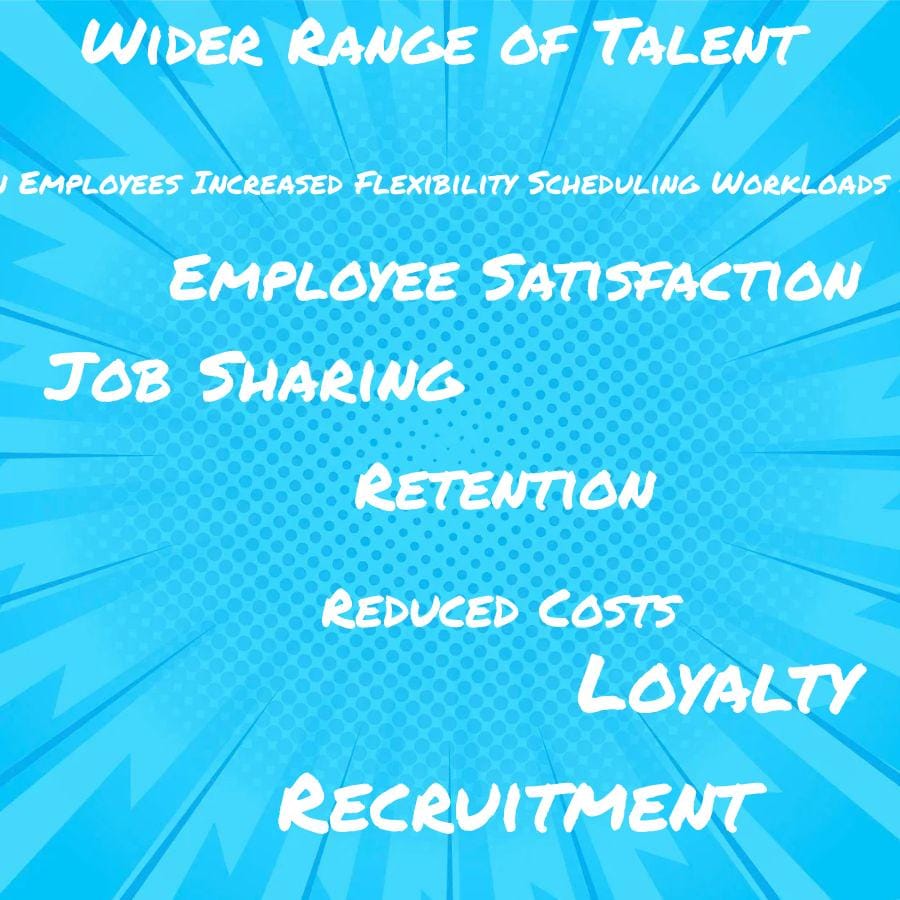Job sharing can provide employers with a number of benefits in terms of recruitment and retention, such as increased job satisfaction for employees, improved morale, reduced turnover rates, and the ability to attract more qualified candidates.
Job sharing is becoming an increasingly popular alternative to traditional full-time employment. It offers employers a number of advantages in terms of recruitment and retention, including cost savings, increased productivity and improved morale.
In this blog post, we’ll explore the benefits of job sharing for employers in terms of recruitment and retention. We’ll look at how job sharing can help businesses attract and retain talented staff, as well as reduce costs associated with hiring new employees.
We’ll discuss the potential drawbacks that come with implementing a job-sharing program.
Recruitment of a Wider Range of Talent

By allowing two people to share one job, employers can access more diverse skillsets and experiences than they would with just one employee. Job sharing also allows employers to tap into different networks and communities that may not have been available before.
This means that employers can find the right person for the job, regardless of their background or experience level. Job sharing gives employers access to a larger pool of potential candidates who may be looking for part-time work or flexible hours.
This makes it easier for them to find the perfect fit for their team without having to sacrifice quality or skill level.
Increased Employee Satisfaction and Loyalty
By allowing two employees to share the same job, it gives them more flexibility in their work schedule and allows them to have a better work-life balance. This can lead to increased job satisfaction as employees feel they are able to manage their own time better, while still being productive at work.
When two people share the same job, it can create a stronger sense of camaraderie between them which can lead to increased loyalty towards the company. Job sharing also helps employers with recruitment and retention by providing an attractive option for potential candidates who may not be able or willing to commit full-time hours due to personal commitments or other reasons.
It also helps retain current employees who may be looking for more flexible working arrangements but don’t want to leave their current employer.
Reduced Costs Associated With Recruitment and Training
By having two employees share one job, employers can save money on the cost of recruiting and training new staff members. This is because they only need to recruit and train one person instead of two, which reduces the overall cost of hiring new employees.
Since both employees are already familiar with the job duties, there is less time needed for onboarding and training them in their roles. This saves employers even more money as they don’t have to spend as much time or resources getting new hires up to speed.
Job sharing also helps retain existing staff members by giving them an opportunity to work fewer hours while still earning a full-time salary. This makes it easier for employers to keep their best talent around longer without having to pay additional wages or benefits packages that come with hiring new people.
Improved Job Performance Due to Increased Collaboration Between Employees
This arrangement can be beneficial for employers in terms of recruitment and retention, as it allows them to access a larger pool of potential employees while also providing an incentive for current employees to stay with the company. One particular benefit that job sharing offers employers is improved job performance due to increased collaboration between employees.
When two or more people are responsible for completing the same tasks, they must work together closely in order to ensure that everything gets done efficiently and effectively. This collaboration encourages communication between team members, allowing them to learn from each other’s strengths and weaknesses while developing their own skillset.
As a result, job performance tends to improve when multiple people are working on the same project or task. This increased collaboration often leads to higher levels of creativity and innovation within teams as well as better problem solving abilities.
Overall, job sharing can provide employers with many benefits related to recruitment and retention by improving job performance through increased collaboration between employees. By encouraging teamwork among staff members, companies can create an environment where everyone works together towards common goals while developing their individual skillsets at the same time.
Increased Flexibility in Scheduling and Workloads
This arrangement offers employers increased flexibility in scheduling and workloads, allowing them to better meet their staffing needs. With job sharing, employers can divide up tasks between multiple employees, allowing them to cover more hours with fewer staff members.
This can help reduce labor costs while still providing adequate coverage for the business’s operations. Job sharing allows employers to recruit from a larger pool of potential candidates since they are not limited by traditional full-time positions.
By offering flexible working arrangements such as job sharing, employers can attract and retain talented workers who may otherwise be unable to commit to a traditional 9-5 schedule due to personal or family obligations. Job sharing also helps create an environment that values work/life balance and encourages collaboration among team members who have different skillsets and perspectives on how best to accomplish tasks.
Reduced Absenteeism and Turnover Rates
By allowing two employees to share the same job, employers can benefit from having two people with different skillsets and perspectives working together on the same tasks. This helps ensure that there is always someone available to cover any absences due to illness or other reasons, reducing the need for costly replacements or temporary staff.
Job sharing can help create a more positive work environment by providing employees with greater flexibility in their schedules and workloads. This can lead to increased employee satisfaction and loyalty, resulting in lower turnover rates over time.